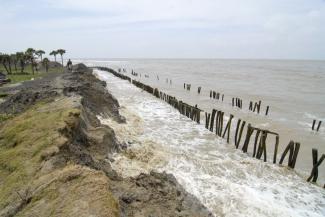Skills training
Empower India’s climate refugees

India and Bangladesh share the Sundarbans, the world’s largest mangrove forest. It is located in the Delta of the Ganga, Brahmaputra and Meghna rivers. On the Indian side, 54 Sundarban islands are inhabited, and another 50 islands are protected for wildlife. UNESCO has declared a World Heritage Site. Tourists come to the Sundarbans to enjoy nature and to spot tigers, if they are lucky.
However, the Delta is exposed to climate change. More than half of the Sundarban villages in India are vulnerable to erosion, breached embankments, storm surges, intrusion of saline water and other impacts. According to the Indian section of the World Wide Fund for Nature (WWF-India), at least 1.2 million people must be resettled in order to prevent disasters that may be caused by cyclones, floods and the salinisation of agricultural land in the future, for example.
The Government of India has announced a National Action Plan on Climate Change, focusing one energy efficiency, renewable energy, sustainable agriculture etcetera. The State Government of West Bengal has also published a Climate Change Action Plan. However, neither plan even mentions migration. There apparently is little awareness of the need to resettle and rehabilitate people in a coordinated manner. So far, not even the UN has officially accepted the term “climate refugees”.
The truth is that more than one million people, most of them farmers and fishers, will have to leave the Indian part of the Delta in the years by 2050. Men will have no option but to leave their families behind in search of unskilled work in distant parts of the country.
We have studied the case of four villages (Ghosh, 2015). To date, more than 50 % of the abled-bodied men have left and moved to 11 other Indian states. Most of them are working as unskilled labourers on construction sites. It would make sense to train climate refugees so they can work as masons, plumbers, electricians etcetera. That would enable them to earn more money, and in view of the booming real estate business in India, their skills would certainly be in demand. Practitioners could provide hands-on training. Schemes of this kind would not cost much. Women, moreover, could be trained to work in garments production and other industries with strong female employment.
The Government of India correctly sees a need to train 20,000 people per year for the renewable-energy sector. It is bizarre, however, that neither the state government nor the central government has ever announced any skill-development programme for the inhabitants of the vulnerable Delta region. The people concerned are becoming victims of a phenomenon they have not caused. The infrastructure of the Sundarbans is poor, and carbon emissions from the area are negligible. On the other hand, the island people have contributed to protecting the mangroves and even planting new mangroves, thus strengthening an important carbon sink. They certainly deserve to be empowered to cope with climate change.
If government agencies fail them, perhaps the private sector could step in. India has made it a rule that large corporations must spend two percent of their net profits on corporate social responsibility. Skills training for climate refugees would be a worthy cause.
A.K. Ghosh is the director of the Centre for Environment & Development (CED) in Kolkata. The CED is involved in the Collaborative Adaptation Research Initiative in Africa and Asia (CARIAA) which is financially supported by Britain’s Department for International Development and Canada’s International Development Research Centre. In this comment, the author expresses his personal views.
cedkolkata@yahoo.com
References
Ghosh, A. K., 2015: Climate change, human migration and human rights with a focus on Indian Sundarbans Delta. Journal of West Bengal Human Rights Commission, 1: 115-122.
WWF-India, 2011: Indian Sundarbans Delta: a vision.
http://www.wwfindia.org/?6362/indian-sundarbans-delta--a-vision












